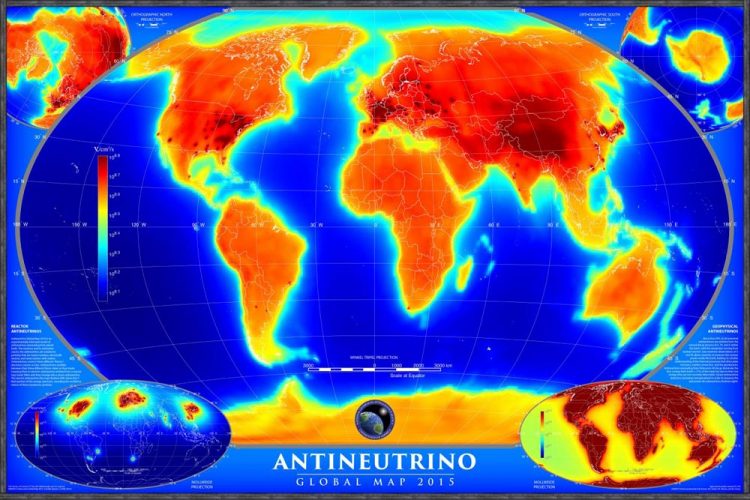First global antineutrino emission map highlights Earth's energy budget

This is the first-ever global map of antineutrino flux, which accounts for natural and human-made sources of antineutrinos, with the latter making up less than 1 percent of the total flux. Credit: National Geospatial-Intelligence Agency/AGM2015
The neutrino and its antimatter cousin, the antineutrino, are the tiniest subatomic particles known to science. These particles are byproducts of nuclear reactions within stars (including our sun), supernovae, black holes and human-made nuclear reactors. They also result from radioactive decay processes deep within the Earth, where radioactive heat and the heat left over from the planet's formation fuels plate tectonics, volcanoes and Earth's magnetic field.
Now, a team of geologists and physicists has generated the world's first global map of antineutrino emissions. The map, published online in the journal Scientific Reports on September 1, 2015, provides an important baseline image of the energy budget of Earth's interior and could help scientists monitor new and existing human-made sources of radiation. The study was led by the National Geospatial-Intelligence Agency with contributions from researchers at the University of Maryland, the University of Hawaii, Hawaii Pacific University and Ultralytics, LLC.
“The interior of Earth is quite difficult to see, even with modern technology. Locating the activity of antineutrinos allows us to create images that our predecessors had only dreamed of,” said William McDonough, professor of geology at UMD and a co-author of the study. “This map should prove particularly useful for future studies of processes within the lower crust and mantle.”
Neutrinos are notoriously difficult to study; their tiny size and lack of electrical charge enables them to pass straight through matter without reacting. At any given moment, trillions of neutrinos are passing through every structure and living thing on Earth. Luckily, antineutrinos are slightly easier to detect, through a process known as inverse beta decay. Spotting these reactions requires a huge detector the size of a small office building, housed about a mile underground to shield it from cosmic rays that could yield false positive results.
In the current study, the team analyzed data collected from two such detectors–one in Italy and one in Japan–to generate a picture of antineutrino emissions from natural sources deep within Earth. They combined this with data collected by the International Atomic Energy Agency (IAEA) on more than 400 operational nuclear reactors. In total, antineutrinos from these human-made sources accounted for less than 1 percent of the total detected.
“Keeping tabs on nuclear reactors is important for international safety and security. But as a geologist, I'm particularly excited for the potential to learn more about Earth's interior,” McDonough said. “This project will allow us to access basic information about the planet's fuel budget across geologic time scales, and might yet reveal new and exciting details on the structure of the deep Earth.”
The team plans to make periodic updates to the global antineutrino map in the future, with the help of improved models of Earth's interior and enhanced antineutrino detection technology. Updates to the map will also reflect the construction and decommission of nuclear reactors as appropriate. All told, the maps will provide an up-to-date picture of Earth's overall radioactivity.
“Antineutrinos are only one particle produced by Earth's natural radiation,” explained Shawn Usman, R&D Scientist at the National Geospatial-Intelligence Agency and lead author of the study. “The National Geospatial-Intelligence Agency is working with UMD to develop additional radiation maps to characterize the Earth's naturally-occurring gamma and neutron radiation.”
###
This research was supported by the National Geospatial-Intelligence Agency, the National Science Foundation (Award Nos. EAR 1068097 and EAR 1067983), and the U.S. Department of Energy. The content of this article does not necessarily reflect the views of these organizations.
The research paper, “AGM2015: Antineutrino Global Map 2015,” Shawn Usman, Glenn Jocher, Stephen Dye, William McDonough and John Learned, was published online September 1, 2015 in the journal Scientific Reports.
Media Relations Contact: Matthew Wright, 301-405-9267, mewright@umd.edu
University of Maryland
College of Computer, Mathematical, and Natural Sciences
2300 Symons Hall
College Park, MD 20742
http://www.
@UMDscience
About the College of Computer, Mathematical, and Natural Sciences
The College of Computer, Mathematical, and Natural Sciences at the University of Maryland educates more than 7,000 future scientific leaders in its undergraduate and graduate programs each year. The college's 10 departments and more than a dozen interdisciplinary research centers foster scientific discovery with annual sponsored research funding exceeding $150 million.
Media Contact
All latest news from the category: Earth Sciences
Earth Sciences (also referred to as Geosciences), which deals with basic issues surrounding our planet, plays a vital role in the area of energy and raw materials supply.
Earth Sciences comprises subjects such as geology, geography, geological informatics, paleontology, mineralogy, petrography, crystallography, geophysics, geodesy, glaciology, cartography, photogrammetry, meteorology and seismology, early-warning systems, earthquake research and polar research.
Newest articles

A ‘language’ for ML models to predict nanopore properties
A large number of 2D materials like graphene can have nanopores – small holes formed by missing atoms through which foreign substances can pass. The properties of these nanopores dictate many…

Clinically validated, wearable ultrasound patch
… for continuous blood pressure monitoring. A team of researchers at the University of California San Diego has developed a new and improved wearable ultrasound patch for continuous and noninvasive…

A new puzzle piece for string theory research
Dr. Ksenia Fedosova from the Cluster of Excellence Mathematics Münster, along with an international research team, has proven a conjecture in string theory that physicists had proposed regarding certain equations….



